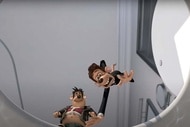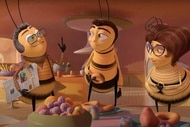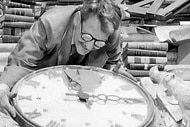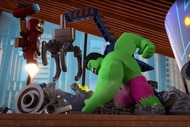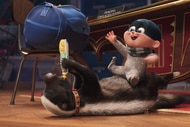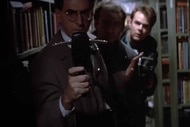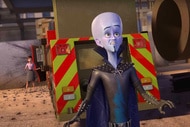Create a free profile to get unlimited access to exclusive videos, sweepstakes, and more!
A thorough oral history of He-Man and the Masters of the Universe, the game-changing '80s toon
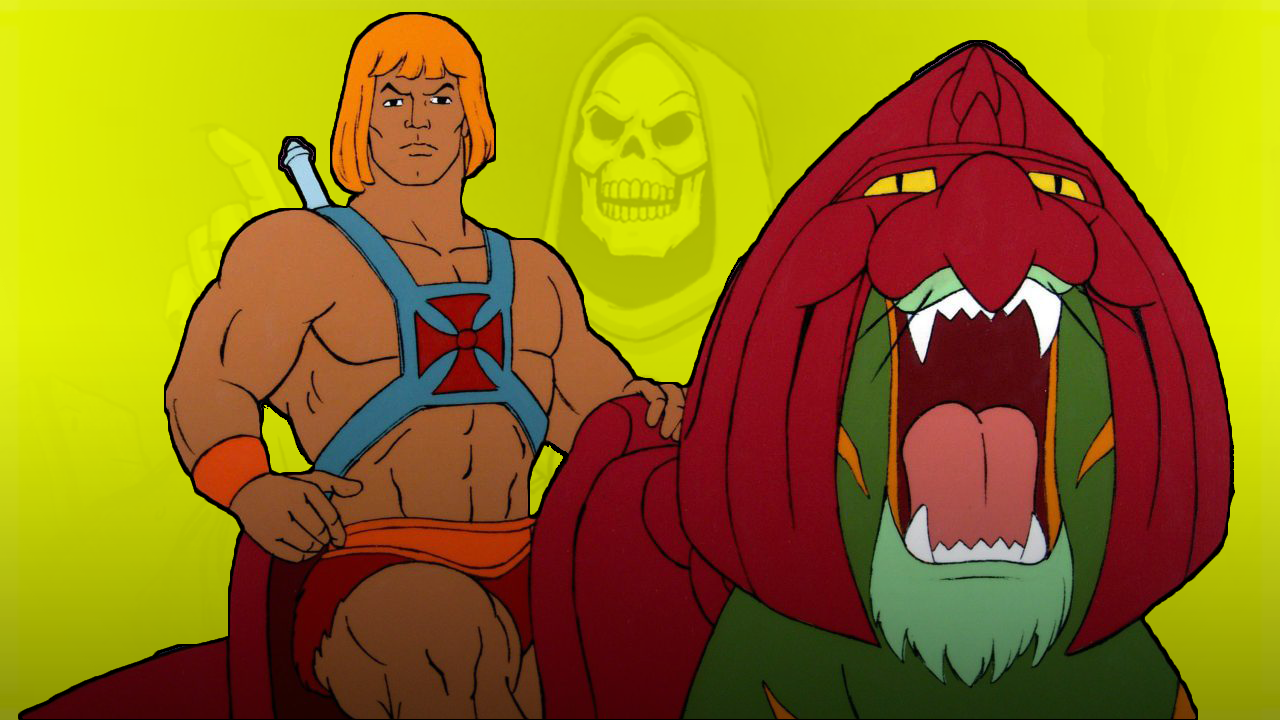
The story behind He-Man and the Masters of the Universe (and She-Ra: Princess of Power) is not an unknown one. As a generational touchstone and defining product of the 1980s, the show has maintained a place of pop culture prominence. And the story about how the show came to be has been explored in depth – most notably in the Power of Grayskull documentary, an episode of The Toys That Made Us, a series of stunning coffee table books from Dark Horse Comics, and a memoir written by late Filmation exec Lou Scheimer (Creating the Filmation Generation).
This is hardly a surprise, considering how influential the show and its characters were on Gen X, the generation with the strongest grip on the pop culture reins right now.
But even though much of He-Man's story focuses on the Mattel toys, the Filmation show was, in many respects, far more groundbreaking. It broke the Saturday morning mold and showed the industry that an animated series could hold its own in a weekday timeslot. It also broke the prevailing business model as one of the first children's shows to air in first-run syndication. Despite its reputation at the time, it was filled with prosocial messages (which set it apart from a majority of animated series). And in an industry that routinely sends work overseas, Filmation made a concerted effort to ensure He-Man was entirely made in America.
The original series also turned out to be a bit of a proving ground for talent that would go on to create or be involved in some of the most influential pieces of the pop culture puzzle. The writing staff included Paul Dini (Batman: The Animated Series) and J. Michael Straczynski (Babylon 5), the music was composed by Haim Saban and Shuki Levy (Power Rangers), and many of the mini-comics that were based on the show and packaged with the action figures were done by Larry Houston (X-Men: The Animated Series).
If we're being honest, the Filmation show is what turned Masters of the Universe into a worldwide phenomenon. The toys gave birth to the characters, but the show cemented their place in pop culture history. It's because of the show that the characters made it to the big screen in 1987 and were rebooted in both 1990 (The New Adventures of He-Man) and 2002 (He-Man and the Masters of the Universe). It's because of the success of the show that She-Ra: Princess of Power was allowed to grow from a spin-off to a phenomenon of its own, whose influence continues to reach into 2019 (with DreamWorks' She-Ra and the Princesses of Power). And it's because the show is such a beloved part of so many childhoods that we might still see another feature film.
SYFY WIRE sat down with several of the people responsible for bringing Eternia (and Etheria) to life through the Filmation series. Together with Alan Oppenheimer, Melendy Britt, J. Michael Straczynski, Erika Scheimer, and Michael Halperin, we take a look back at the groundbreaking show that defined a generation: He-Man and the Masters of the Universe.
Mattel began developing their Masters of the Universe line of toys in the late 1970s. The first action figures went on sale in 1981, but a year prior to that, Mattel approached Filmation to help them market the new toys.
Erika Scheimer: Way back, in about 1980, Mattel came to Filmation to do the animation in a He-Man commercial of theirs. Coincidentally, at the time, my dad [Lou Scheimer] was developing a Conan-type show called Blackstar. My dad was very fond of that kind of genre. So they did this commercial, which started the relationship, and it got my dad thinking, "Maybe we could do this He-Man as its own show." At that point in time, in 1980, Filmation was bought by Westinghouse. My dad talked to the people at Mattel and said that he really wanted to develop a show around the character.
The Mattel-Filmation relationship was thus established. And by 1982, Mattel had a legitimate success with their Masters of the Universe toys. However, they were getting a lot of phone calls and letters from confused parents and kids who had bought the action figures. Aside from He-Man, it was unclear who was a "good guy" and who was a "bad guy." Kids didn't know how to play with the toys.
Michael Halperin: I was contacted by Mattel for the specific reason that I had written a sword-and-sorcery screenplay (that was never produced). They read it and thought that I would be the perfect person to come in and work with them on Masters of the Universe. They were having trouble marketing the toy. Not that it wasn't selling well. It was selling well. The problem they were having is that they would get phone calls and letters from parents of kids who had purchased the toys. And they didn't know who were the good guys and who were the bad guys, except for He-Man. He was obviously the hero.
So they wanted to have someone come in and give a sense for who the good guys were and who the bad guys were. I suggested that we also do some background on each of the characters to explain motivations. I was very interested in mythology and literature, such as the Epic of Gilgamesh and Beowulf. I love Beowulf and thought he was an archetypal character when I thought of He-Man. So I based the character on Beowulf — not, as a lot of people think, on Conan the Barbarian. The modeling of the character might have been influenced by Conan, but I wasn't the artist or modeling the toys themselves. They brought me in to write all the background materials for the characters.
Parents wanted to know who these characters were. Who were the white hats, and who were the black hats? That was my job at the beginning.
Prior to this, there was no "world" for the characters to inhabit. The action figures had names and little else.
Halperin: There was nothing. I came in and created planet Eternia. I even at one point drew a map of Eternia with all the place names and labels. Now, I'm not an artist, but I handed over my crude map to the artists, and they created this wonderful map of Eternia. We also had this enemy—Skeletor — and his minions, which I called the Lords of Destruction. But there was no place for him. He didn't have a headquarters. He just lived "over there."
So I came up with the name Snake Mountain. I had no idea what it was supposed to look like. I just had a vague idea in my mind. My children were very young at the time. My oldest was 10 years old, but he was very good at drawing. So I asked him what he thought Snake Mountain would look like. And he actually drew a picture, and I gave that to the artists. They used that drawing to flesh it out, but his drawing had most of the prominent features we ultimately saw on Snake Mountain. He never got a penny for that drawing, though!
In early 1983, with some backstory for the characters filled in and the toys a roaring success, Mattel made a deal with Filmation for an animated series.
Halperin: They wanted me to be a creative consultant and write the bible for the show. My task then primarily was as a liaison between Mattel and Filmation to ensure that the animated series would reflect Mattel's needs and desires in terms of the characters and toys and that there would be no confusion among the viewers.
At the same time, Mattel was going to package these comic books with the toys. They did three or four of them prior to my coming aboard, and each one of them had a different origin story. It was as if everyone wanted to do their own thing. I knew we had to have consistency. Otherwise, how would anyone know what was going on with the characters unless we have a consistent story? So the bible I wrote became the story and character guide not only for Mattel's marketing but also for the animated series.
Filmation had done a proposal for Mattel to present to television stations to sell the series. It was a very superficial pitch, which is not unusual. A pitch is usually very short. So what they were looking for [from me] was an in-depth exploration of the characters, the story, and where it took place, so when they finally started doing the animation, the writers and directors would know exactly where we were in space so it would all make sense.
Scheimer: My dad spent over a million dollars developing He-Man. Mattel gave us a bible that wasn't something that Filmation would produce. So my dad started from scratch. And Mattel put no money into the development of it. My dad made it very clear to them that we were going to finance the show, we were going to get it on the air, and [he wasn't] going to allow them to tell him what toys we had to put in it.
He managed to get the whole thing to be wholly subsidized by Westinghouse. I'm sure it seemed like too good a deal to be true for Mattel because they didn't have to come up with much of anything. So Filmation had carte blanche because we funded it. And we could choose which toys we would or wouldn't use. They didn't make us do anything. And as a result, [Lou] had complete and total creative control.
The bible — which described the world of Eternia, how Prince Adam became He-Man, and all the supporting characters — was turned over to Filmation. (It's available here for your reading pleasure.)
J. Michael Straczynski: Initially, there was a fairly surprising degree of flexibility in the storytelling. Mattel mainly got involved in terms of sending along lists and photos of new toys they wanted worked into the series. Beyond that, we were left largely to ourselves as long as we colored within the lines of common sense by not going after topics that were too controversial.
I'd been a fan of the first season of He-Man, which may seem dopey but true. I could tell that some serious thought to world-building had been done in the show, and I very much responded to that. I was still fairly new to TV scriptwriting at the time, so the tools I had to use were limited, but I set out to tell the best stories I could with what I had.
Halperin: I wanted to create characters that reflected the idea of the classic myths but with a spin on it. I didn't want to do something that was already done. I wanted to have a hero who was brave and strong and almost invulnerable but who used his wits rather than his brawn. He only used his strength when it was absolutely necessary. That was my goal. And since it was aimed at children, I wanted them to understand that you don't need to punch someone in the face to get your way. That was the goal — to create a better world.
I worked with Filmation almost every day for the first year. When you're doing a show like this, you need to set rules. They can be crazy rules. And, obviously, He-Man has rather odd rules because it combines the technologically advanced society and a primitive setting. So every story has to work within those boundaries. That was part of my job. That was the goal of the bible.
I reviewed every single story that came through and made comments on them. And then I would give them back to Lou Scheimer or the producer of the show. I'd say, "This works" or "This doesn't work" or "How about doing this instead?" They were receptive to my notes, but I know there was a feeling that I was being intrusive.
One of the problems that Mattel had was the contract I had said that my job was to approve all stories that went into the series. The problem is that it didn't say all the scripts had to be approved. Very often, I would have arguments with Filmation about some of the stories, and they would just go off and do their own scripts. That doesn't mean the show was not a success. It was obviously an incredible success from the get-go.
But I had clashes with Filmation because my loyalty was to Mattel. It was loyalty to the idea of He-Man. There were clashes, but those were creative clashes that happen all the time on television series. I've worked on a lot of them over my career. So when I say "clashes," I mean legitimate discussions about stories, what works, and what doesn't. So even though it wasn't quite what I wanted it to be, I was just one person. Mattel supported me, but the show had to get on the air. You can only argue up to a point. But I loved working with everybody on that show.
Though there's really no such thing as an overnight success, He-Man and the Masters of the Universe was as close to one as possible.
Scheimer: After I graduated from Stanford, I started to work full time at Filmation the week that He-Man aired. So I was there for "Oh my god, we changed the face of television! Oh my god, we have a massive hit!" It was pretty apparent within the first month. It was unbelievable. It just struck a chord.
From the get-go, Filmation faced an uphill battle with the amount of action (i.e., violence) they had in the show.
Scheimer: Even before the show hit the air, the interest groups heard the title and started complaining about the violence in the show without ever seeing a single thing. And I mean, come on, the show had action, but there was no hardcore violence. But it was excoriated by the Peggy Charrens of the world and all those do-gooders. They were all complaining, but they hadn't even seen the show!
Filmation needed to come up with a set of "rules" about how to depict violence on screen.
Scheimer: I have to go back to Fat Albert, and it's shame that's become a dirty word. But in 1971, the surgeon general came out with a report on the state of children's television. So my dad sold this show, Fat Albert and the Cosby Kids, that was filled with prosocial messages. He had a psychologist who was going to go over every script and make sure everything was age-appropriate. So he started that habit of having an educational consultant, and we had an educational consultant on He-Man.
We couldn't use the same guy that worked on Fat Albert because he was exclusive to CBS. But at that time, I was at Stanford and in a communications class. In that class, the professor said that all of children's television sucked except for one show: Fat Albert and the Cosby Kids. Bottom line is, when He-Man came around, and we needed an educational consultant, we got Don Roberts, my professor from Stanford!
When people came around and claimed that He-Man was no good and didn't follow any values, we could point to the fact that we had an educational consultant from Stanford who reviewed the scripts. There's a difference between violence and action. So we had someone on retainer who was checking our backs and making sure we weren't doing anything wrong.
Straczynski: We all knew we were making a show that was predominantly (though not exclusively) for kids, so we weren't going for scenes of gore and bloodshed. That being said, sometimes Arthur [Nadel, producer] would balk at the weirdest things when it came to action. On one occasion, he balked at having He-Man hit someone with a tree because it would kill the tree, so the tree had to be clearly and visually dead to begin with. His big thing was to throw the bad guy out of frame, because once they were out of frame apparently we never had to worry about them again.
For a show with dozens of different characters, there were surprisingly few actors. There was a core cast of just four (excluding Lou Scheimer, who voiced Orko, King Randor, and a host of second-tier characters) that gave Eternia its voice. That cast consisted of John Erwin, Alan Oppenheimer, Linda Gary, and George DiCenzo.
Alan Oppenheimer: I had a long theatrical career at Arena Stage in Washington, DC. I was there 10 years, from 1954 to 1965, and did 60 plays. It was the best part of my career; I loved it. Once I moved to Los Angeles in 1966, I immediately started doing television and theater. I then started doing cartoons in the '70s with Hanna-Barbera. I auditioned for Masters of the Universe in 1980-something with Lou Scheimer. We found out later that we went to Carnegie Tech at the same time. I was on the first floor as a drama student; he was on the third floor in painting and design. We also found out we were dating the same girl — at different times, though, thank god for that. Anyway, that was my first show at Filmation. I did everything at Filmation after that, based on the success of He-Man.
Scheimer: Once I started at Filmation, that core started to expand some. I wanted somebody new. I was new blood, and I thought, "We need somebody besides Linda Gary!" She's great, I love her, and she's terrifically talented, but we need something new. Hence, Melendy Britt [as She-Ra]. I'm the one who got her the job. My dad almost fired me because I was so insistent. I really wanted her so much. It was like, "I love your core group of actors, dad, but we need something different!" You know how young people are.
Halperin: When they animated the opening credits and the sequence of Prince Adam holding up the sword and saying, "I have the power," you see Cringer turn into Battle Cat. In the original version, Battle Cat said, "I have the power, too." And that just felt wrong to me, so I talked them out of it. The version you see today doesn't have that dialogue, but if you read his lips, you'll see Battle Cat saying, "I have the power, too!"
The actors were given minimal direction when coming up with the voices. And in the early 1980s, there was no post-production or effects done on their voices.
Oppenheimer: As I best remember it, they just said, "What do you think would be a proper voice for this character?" And, really, the skull head immediately dictated what I should do with it. And as the show went on, it got a little more refinement, and there were certain things I stressed based on the public reaction. But the first idea was the one that prevailed.
I also did Mer-Man and Cringer and Man-at-Arms. And they were 100% me. Because Mer-Man was supposed to be in water, I talked through a gargle. That's all I did. And that was immediate. They showed me the drawing, and he was in water, and I had the voice.
I don't believe [Skeletor] was meant to be a comedic villain in the beginning. I always look for comedy in the most tragic of circumstances. You see it all the time on the news. Someplace burns down and they say [chuckling], "Well, I guess we'll just start over." Damn it, that's how people survive. So that's why I put the laugh in, and it just makes the character. Otherwise, he's just a snarling, mustache-twirling villain. I'm not interested in that.
Recording was mostly done as group, with the exception of Lou and Erika Scheimer, who managed the recording sessions and would do all of their lines during post-production.
Oppenheimer: We recorded from the script, like radio. Then they animated to what we did. Lou would come in later, after we'd all gone home, to do Orko and anything else he needed. He'd come in after everything was put together. You didn't need to match anything to Orko's lips because he had a hood. You couldn't see anything.
Scheimer: We had our core group of folks and would record together, like a radio series. That's what my dad grew up with. [In the beginning,] my dad did the recording sessions, and once I came on, then I did them. I had the majority of the cast there. I'd have John Erwin, Linda Gary, Alan Oppenheimer, and George DiCenzo all there. We would record with the main characters, and then my dad and I would come in and finish up the bit parts. This was also just a way to make the economics work. We did all the animation in this country, and it cost more doing that. So we had to find ways [to save money].
In contrast to most voiceover actors, Alan Oppenheimer would record all of his characters in one take. For example, if a scene had a conversation between Skeletor, Mer-Man, and Cringer, he would jump back and forth among the characters and have a conversation with himself.
Oppenheimer: Most actors don't do that. They do one voice all the way through. But I enjoyed playing opposite myself. It energized me, it energized the performance, and we had great fun doing it. One time, Lou Scheimer had me record a bunch of insults all in a row. He said, "Just record whatever you want." Well, I think maybe two of them got on the air. They were a little too insulting, I guess. It was really toilet humor.
To satisfy the broadcast standards of the time (and respond to growing criticism of the show), episodes concluded with brief segments that recapped the events and drove home a moral to the story.
Halperin: We hired a child psychologist to write those endings. This was in response to a major outcry by parents' groups that complained the show was nothing but a half-hour commercial for He-Man toys and was very violent. We needed to do something to ameliorate that. Each episode had to have its own message, so the endings were written based on the script to that episode. Later on, I started writing them myself. I'd rather have them integrated than tacked on.
Scheimer: If you've happened to watch an episode of Fat Albert, you'll see that that happened at the end of every Fat Albert, too. We wouldn't just add on a moral that didn't relate to the story at all. They were appropriate. So we wanted to continue that method. And then we did the same thing with She-Ra. So it was something that was developed in 1971 for Fat Albert and seemed to be a good way to reinforce the prosocial message of the show.
Straczynski: We [the writers] hated them because they were clearly pandering to pressure groups to give the shows some social value. Even though, in many cases, it was already there; the episodes had a moral POV of their own. Then you'd have the flip-side of that, where we'd do an episode absent of any kind of moral compass, and there'd be this "always be nice to strangers" moral that was tacked on and dopey.
He-Man (and later, She-Ra) is notorious for these endings, and in 2019, it's far too easy to poke fun at them and find them corny and contrived. But they had power. And they literally changed and saved lives.
Scheimer: I can't tell you the number of stories I've been told about kids who were close to suicide and then heard a moral that told them to find a friend if they're feeling down. I can't tell you how many stories I've heard of gay young boys who were made whole by She-Ra. It's amazing how touched people were by these messages. Girls who were molested and finally talked to their parents because they saw the show that said, "If someone touches you in a place you don't want to be touched, talk to your parents or teacher." It blew me away.
There was a young autistic girl I met, and I forget the exact moral now, but it gave her such strength. She wanted to be "like everyone else," and she knew that she could. It's just amazing. The blind boy who listened to He-Man religiously and talked about what it meant to him. I can go on and on and on. It still gives me goosebumps to this day.
Oppenheimer: One of the first conventions I did, in Miami, three young men came up to me and told me a story about the moral "If you get separated from your parents, stay there and don't wander around." One of them told me that absolutely happened to him. He was from Argentina and was hiking with his family in the Amazon, and he got separated from them. And he started to walk around but remembered the moral. He stayed there, and they found him two hours later.
It's been quite a surprise. I've hugged a lot of people.
Lou Scheimer was hands-on and involved at Filmation, but he still gave a lot of freedom to the other creative talent (writers, animators, actors) working on the show.
Oppenheimer: He gave total control. Total. He would also make suggestions, because he directed them, too. But otherwise, he cast you, he trusted you, and we gave him good work. He was a very, very kind man. So his suggestions were never critical. They were always helpful.
Scheimer: My dad read every single script. He did the final cut of every show. He dubbed it. He mixed it. He was incredibly involved. Everything went through him. He wasn't one of those guys that just went and did the deals. He was an artist first. Making the shows – that's what really got his blood going. He gave tons of freedom, with the caveat being: If we can afford it. Look, we'd love to have been able to do fuller animation. People had the freedom to come up with all sorts of ideas and share their opinions, and sometimes he'd go in that direction – it wasn't like my dad was an autocrat.
Straczynski: The whole time I was at Filmation, I only saw Lou twice and never heard anything directly from him otherwise. He set himself as kind of the creative center of all of Filmation's shows, but that was really just PR. He was a salesman and a front-man, and he voiced a bunch of characters himself to get the residuals rather than bringing in outside actors. The day-to-day control over He-Man lay with producer Arthur Nadel who took pitches, worked with writers on outline and scripts, gave notes, and coordinated with the art department. Arthur gave me a fair degree of latitude because I was a quick writer and really got the characters, so his notes were generally pretty minimal, often consisting of just DB, his written note for "do better."
In the hall outside the animators' wing was a chart labeled "The Many Faces of He-Man." There were drawings of his face designated as He-Man Angry. He-Man Sad. He-Man Happy. He-Man Confused. This went on for something like 16 different emotions. They were all the exact same drawing. It was kind of a nod to the extremely limited animation we had to work with. And nobody ever pulled it down.
Right or wrong, He-Man and the Masters of the Universe has become the poster child for '80s animation that began as an elaborate toy commercial. Internally at the time, though, nothing could be further from the truth.
Halperin: I saw it as something different; however, I was specifically aware — because I was working for Mattel — that there were times when they'd say, "You know, we'd like to get this new vehicle in the show." And so I had to say OK because they were paying the bills. But whether the show was an elaborate toy commercial? It wasn't. When the show was syndicated, the FCC had a rule that said we could not have a Mattel commercial showing during the show itself. Mattel was not allowed to advertise any of its He-Man toys in the show.
Oppenheimer: The toys were not a part of the show when we were recording. They had absolutely no influence on what we did or even thought about.
Straczynski: I can't say that none of us thought [the show was just a toy commercial], but I can definitely say that most of us thought there was value in what we were doing. I think you have to believe that or make yourself believe it, in order to produce anything of substance. I think one of the main reasons the show succeeded then, and has endured now, is that there was a lot of heart to the storytelling. There was some dopiness and silly stuff, sure, and there were some writers whose interests didn't go much beyond cashing a paycheck, but at its core, the show was about people who cared for and about each other, and I think that resonated.
Scheimer: A show is fundamentally about relationships and people, and that's what we focused on at Filmation. I know everything thought that whatever new toy Mattel came out with, we had to use. No. No we didn't. We only used those toys that worked for us. We were not forced to use any toy that we couldn't really justify. I mean, of course the show was filled with toys! But do you think the Prince Adam figure sold well?
Melendy Britt: We just went in and really didn't think about anything else but our performances. We knew nothing about that side of the business.
A lot of people who work in film and television claim that the projects on which they work are "just a job." They don't have the emotional connection to the material that many fans do. For those who worked on He-Man, though, the connection ran deeper.
Oppenheimer: It was a job. That's it. I worked from, say, 10:30 until 12. Then I had another recording session at Hanna Barbera or I had a voiceover for a commercial or I was in rehearsal for a play. It was a job. The biggest surprise was the resurrection of this and the fans! Listen, here it is, 30 years later, and I'm doing these comic-cons. This is a whole new career. I never thought [this would happen]. I got paid, went home, and was happy to have done the recording. That was the end of it for me. But here, 30 years later, these characters are so popular, and I've got about a dozen comic-cons already listed for 2019! It's absolutely amazing!
Halperin: When I first came in, it was just a job. When you're working on a show, you're not looking 10 years into the future. You're looking at, "What do we have to do to get the show out the door?" Whenever I write anything, I take it very seriously. It's never "just another assignment." I've written a lot of shows that some people have called "dumb," which were very successful, but when I wrote it, I didn't think it was a dumb show. If I did, I couldn't write it. In the case of He-Man, I always saw it as having an arc of reality with a subtext of fantasy.
Straczynski: For me, and Larry DiTillio, and many others who worked on the show, it was something we liked and cared about. If you're doing something that you consider "just a job," you're never going to do anything of value. The writing will be flat and uninteresting, and the work itself deeply unsatisfying. I think you can find a corner of fun and interest and decency in even the silliest or most trivial project. That allows you to create things you feel you can stand beside creatively and with at least a modicum of integrity. If you can't do any of that, then you shouldn't do the job. And that applies to a lot of jobs, not just scriptwriting.
Britt: No job to me is "just a job." On every job, my artistic integrity is on the line, and I love and am very grateful to have been given a gift and to have been trained for this profession. I do my best with the conditions I'm given on every project (and some aren't always ideal!). Plus, it was a great laugh fest because those guys playing the male roles were some of the most clever and funny guys I've ever known!
Scheimer: Let me put it this way: Filmation closed 30 years ago in February, and we're all planning a 30-year reunion. It was a family, and we were proud of what we did. We wished we could compete with the animation of Disney, but you can't do that for television. When He-Man became a hit, it meant something to at least 90 percent of the people there. They really cared. It was a very special place.
The success of He-Man spawned many things, but perhaps the most significant effect it had was the creation of She-Ra: Princess of Power. But was She-Ra intended to be just "He-Man for girls"?
Scheimer: My dad had two very strong, feminist females at home. He felt a moral obligation. I hate to make him sound like a Pollyanna, but he really was! He was this honest, decent guy – kind of like who we think Jimmy Stewart was. That's really who he was. So when He-Man went on the air and became a success, he instantly knew that we had to serve girls, too. They deserve to have something, too! So he went to Mattel and said, "Hey, I want to do a girls' version of He-Man. Because the girls are underserved."
Little did we know that the LGBTQ community would be just so served and excited about it. That's one thing that's really amazing about She-Ra. And continues to be. I'm really proud of how Noelle Stevenson [on She-Ra and the Princesses of Power] has carried on the banner of appealing to a broad spectrum of folks and creating an inclusive show. Hats off to her for that. I'm sure my dad is cheering her on up in heaven, if there is one.
Britt: I had no directive except to give it my personal interpretation as a powerful female superhero. Although I'd heard of He-Man, I had no idea about what the show was like. John Erwin was a client at the same agency that I was at. I auditioned as others did and had meetings with the producers.
Straczynski: Filmation didn't have a lot of "directives." Once they made the deal with Mattel, they just kind of left us to figure it out. One of the things Larry [DiTillio] and I decided, very early on, was that She-Ra couldn't just be "He-Man with boobs." The show had to go deeper than that, especially given that we were creating this for a female lead character.
We decided to turn a lot of that previous model upside down. So in the original series, He-Man fights to maintain the status quo against forces out to pull down the monarchy and destroy the established order of things. In She-Ra, that's reversed. She's in a resistance group trying to pull down a government of occupation. (I think this may have been the only show with that motif at the time.)
The only directives came when we were well into the writing process, when Filmation and Lou engaged the services of consultants who tried to do as much damage as possible to the idea of a strong female lead. They gave instructions that while she had a sword, she wasn't allowed to use it against anyone because that wasn't ladylike. We had to make it a rope or the like. They didn't want her to punch anyone, but rather do a ballet-style kick that hits the bad guy almost by accident and (once again) throws them out of frame.
These and other allied notes were invariably sexist, misogynist, patriarchal, and patronizing, and we fought like hell against them, which did not endear us to Nadel or Lou, who would've much preferred it if we'd just do our job and shut up. This, combined with not getting proper credit for developing the show, and not being credited as story editors when we were doing that work, was what ultimately led Larry and me to leave the show.
She-Ra burst out of the gate and immediately set a new standard.
Straczynski: After joining He-Man, I quickly joined Larry as the two guys who were at the core of the show's writing staff. Between us, we generated a hideous amount of material in a very short time, and we were known to be world-builders who kept expanding the show's historical and mythological baseline. So when they decided to launch a sequel series, we were assigned to create and develop the characters, the world, the plots, the alliances, and the rules, which we incorporated into a series bible that we wrote together. We were also tasked with supervising and rewriting freelance writers (which began to cause a problem for us because that's the work of story editors, and we were only being credited as staff writers) as well as writing our own scripts.
Since we were dealing with a (relatively) consistent universe, and She-Ra was He-Man's sister, most of the rules of that universe carried over. Even the Horde had been introduced a bit in He-Man. Where we decided to plant our flag was in making this a very female-centric action series, differentiated from He-Man where it was all testosterone with the female characters often in supporting (or neglected) positions.
All the other action-oriented animated series of the time were also very male-centric, so we wanted to take this opportunity to create a character, and a world, that would show girls that it's okay to be heroic, that you can have a female character who's the lead of an action TV series. And for a lot of girls at that time, She-Ra was the only character around who they could identify with in that way as a role model.
He-Man and the Masters of the Universe turns 36 this year, and it seems to be just as popular as ever. The show, characters, and stories still hold up. And the messages they carried in 1983 are just as relevant (if not more so) in 2019.
Britt: The style is of course dated as they were over 35 years ago, and animation technology for TV has much more money behind it today. I think the only animation that has really stood up over time and is not criticized for the style are maybe the first color Disney animation films. But, I'd hope [modern viewers] take away the heart and the message of the show. That's what was important.
Straczynski: When the She-Ra and He-Man reruns showed up on Netflix, I watched some of them, a mix of my episodes and those by others, mainly Larry. Some of the animation is quite pretty, but much of it is just not up to modern standards, especially since so many sequences (walking, running, fighting) were recycled across episodes. So some episodes hold up better than others. Most things in life come down to a bell curve, and it's no different with these shows. At one end are the solid episodes, at the other end are the episodes you wish someone would drop off the end of a pier somewhere, and the rest are somewhere in the middle.
Oppenheimer: I'm sure they [hold up] because of all these people coming to the comic cons, and they're bringing their children.


